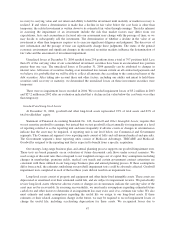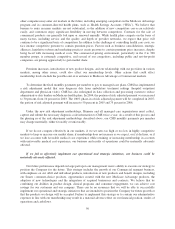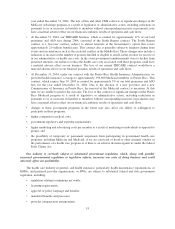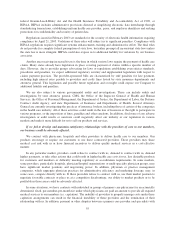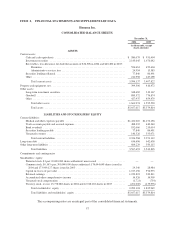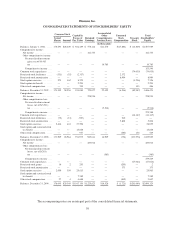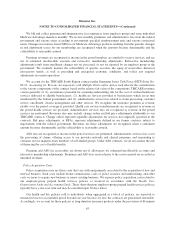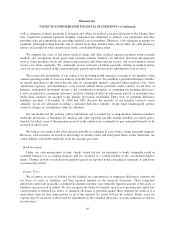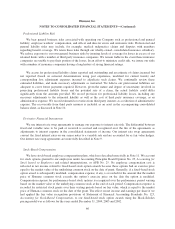Humana 2004 Annual Report Download - page 66
Download and view the complete annual report
Please find page 66 of the 2004 Humana annual report below. You can navigate through the pages in the report by either clicking on the pages listed below, or by using the keyword search tool below to find specific information within the annual report.whom the primary care provider contracts can result in a disruption in the provision of services to our members
or a reduction in the services available to our members. The financial instability or failure of a primary care
provider to pay other providers for services rendered could lead those other providers to demand payment from
us, even though we have made our regular fixed payments to the primary provider. There can be no assurance
that providers with whom we contract will properly manage the costs of services, maintain financial solvency or
avoid disputes with other providers. Any of these events could have an adverse effect on the provision of services
to our members and our operations.
Our ability to obtain funds from our subsidiaries is restricted.
Because we operate as a holding company, we are dependent upon dividends and administrative expense
reimbursements from our subsidiaries to fund the obligations of Humana Inc., the parent company. These
subsidiaries generally are regulated by states’ Departments of Insurance. In most states, we are required to seek
prior approval by these state regulatory authorities before we transfer money or pay dividends from these
subsidiaries that exceed specified amounts, or, in some states, any amount. In addition, we normally notify the
state Departments of Insurance prior to making payments that do not require approval. We are also required by
law to maintain specific prescribed minimum amounts of capital in these subsidiaries.
Debt ratings are an important factor in our competitive position.
Claims paying ability, financial strength, and debt ratings by recognized rating organizations have become
an increasingly important factor in establishing the competitive position of insurance companies. Ratings
information is broadly disseminated and generally used throughout the industry. We believe our claims paying
ability and financial strength ratings are an important factor in marketing our products to certain of our
customers, and our debt ratings impact both the cost and availability of future borrowings. Each of the rating
agencies reviews its ratings periodically and there can be no assurance that current ratings will be maintained in
the future. Our ratings reflect each rating agency’s opinion of our financial strength, operating performance, and
ability to meet our debt obligations or obligations to policyholders, but are not evaluations directed toward the
protection of investors in our common stock and should not be relied upon as such. Downgrades in our ratings,
should they occur, may adversely affect our business, financial condition and results of operations.
Increased litigation and negative publicity could increase our cost of doing business.
The health benefits industry continues to receive significant negative publicity reflecting the public
perception of the industry. This publicity and perception have been accompanied by increased litigation,
including some large jury awards, legislative activity, regulation and governmental review of industry practices.
These factors may adversely affect our ability to market our products or services, may require us to change our
products or services, may increase the regulatory burdens under which we operate and may require us to pay
large judgments or fines. Any combination of these factors could further increase our cost of doing business and
adversely affect our financial position, results of operations and cash flows.
ITEM 7a. QUANTITATIVE AND QUALITATIVE DISCLOSURES ABOUT MARKET RISK
The information required by this Item appears in Management’s Discussion and Analysis of Financial
Condition and Results of Operations—Item 7 herein, under the caption “Market Risk-Sensitive Financial
Instruments and Positions.”
56



